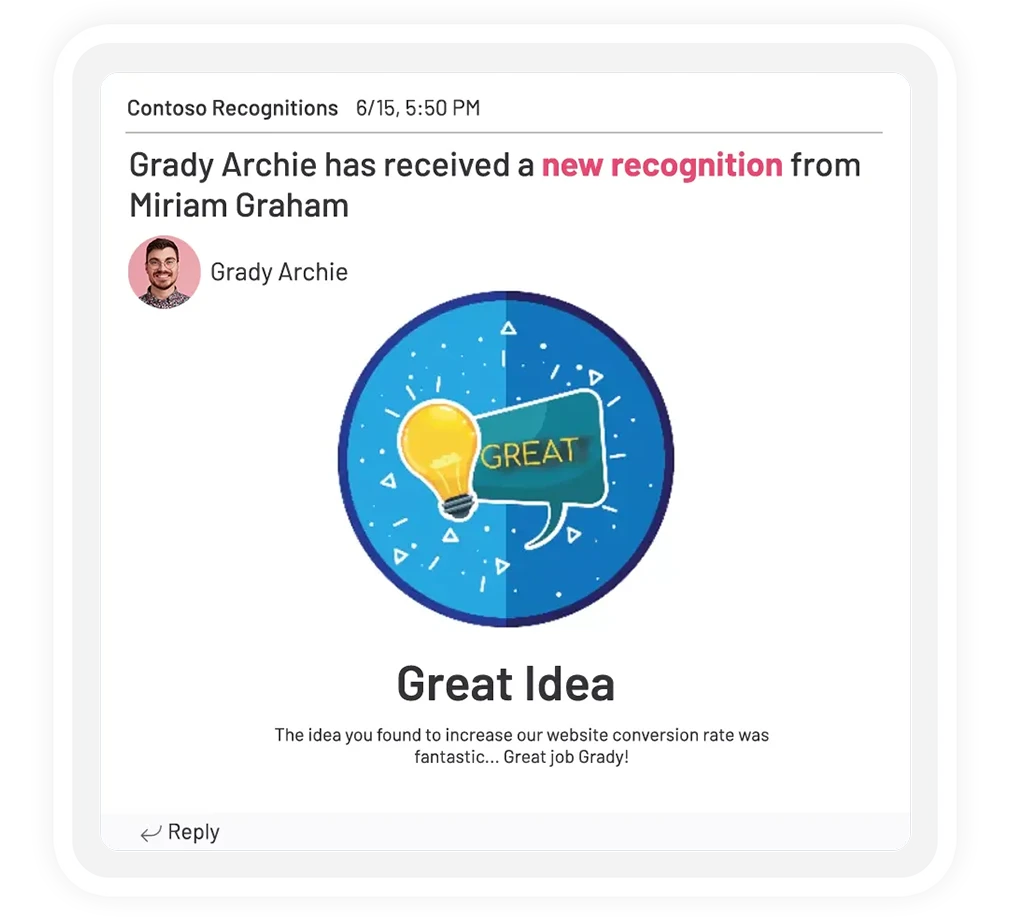Recent data from Gallup’s January 25, 2023 report reveals the concerning truth about employee disengagement. Out of 67,000 employees surveyed, nearly 32% displayed signs of engagement at work, while 18% were actively disengaged.
What’s astonishing is that the ratio of engaged to actively disengaged employees hit its lowest point in the United States since 2013.
It looks like employee disengagement is one of the biggest problems for organizations. So, we’d like to dig deep into the psychology of it, talk about the costs, best practices for engaging your employees, and more!
So, without further ado, let’s get started!
Table of Contents
What is employee disengagement?
To define employee disengagement, we can start with the definition of employee engagement, which was coined by William A. Kahn in 1990.
According to Kahn, when people are engaged in their roles, they’re not just physically showing up, they’re also mentally and emotionally present. In other words, they’re using their skills and knowledge while genuinely caring about what they do.
There are different definitions of employee engagement, but at its core, employee engagement boils down to having the energy, involvement, and willingness to help your organization succeed.
But employee disengagement isn’t solely about how an employee feels about their job. It’s a two-way street. It also includes the organization’s capacity to provide its employees with good management and a positive working environment.
So, an employee needs to have the enthusiasm to accomplish company goals, while the organization should offer the conditions in which an employee can thrive.
Lastly, it’s important to note that there are three levels of employee engagement.
Engaged employees have the motivation to contribute to the success of their organizations.
Not engaged employees do not try to exceed the performance expectations, their performance is only satisfactory.
Actively disengaged is the most dangerous because they perform poorly but they also cause a decline in morale by discouraging high performers.
Now that we have talked about the fundamentals of employee disengagement let’s discuss the underlying causes of it.
What are the reasons for employee disengagement?
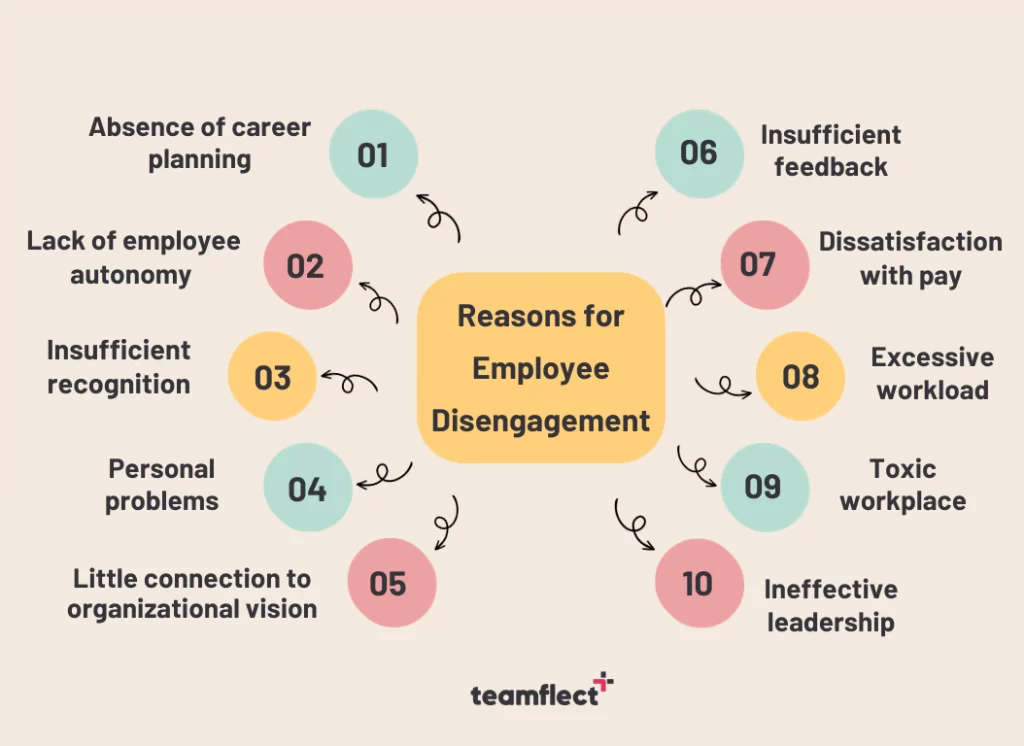
Employee disengagement can be occasionally out of your hands but most of the time there’s something you can do to keep your team members engaged.
To tackle this issue, it’s important to understand why employees might be feeling disengaged at work. So, what are the common reasons for employee disengagement? Let’s explain them one by one.
1. Absence of career planning
Career planning means that when an employee starts working, they will be able to move within an organization.
According to a 2015 survey by CEB, which was conducted with 12,000 employees, career growth opportunities were the top reason employees switched jobs.
Managers and employees should talk about career opportunities and address career planning. Managers can even be like mentors for their employees, guiding them while ensuring that they are on track toward the next chapter in their careers.
2. Lack of employee autonomy
Lack of employee autonomy might mean that managers are excessively controlling toward their employees, that’s what we call micromanagement, and it’s no fun.
This type of management can make direct reports feel like they’re not in charge of their own work, and it can be stressful to work under such managers. In contrast, having autonomy to decide how to tackle tasks can actually make your work less stressful and improve your overall well-being.
3. Insufficient employee recognition
Everyone likes a pat on the back once in a while and it’s not about seeking constant praise, but just knowing that someone sees your efforts and appreciates them.
For this reason, researchers recommend using monetary recognition as well as non-monetary incentives such as verbal or written appreciation because it increases motivation, efficiency, and job satisfaction. (Long & Shields, 2010; Montani, Boudrias, & Pigeon, 2020).
Furthermore, according to a Gallup article by Annamarie Mann and Nate Dvorak, recognition at work provides a sense of achievement while motivating employees and making them feel valued for their contributions.
4. Personal problems
Your employees might be going through some personal problems that are taking a toll on their energy and motivation. When that happens, you’re not expected to be their therapist, but you can suggest they seek help or support from other sources.
5. Little connection to organizational vision
People seek meaning and purpose in their jobs because it gives them a sense of direction, so if you didn’t communicate your company vision and mision to them, they might become disengaged from work.
6. Insufficient feedback
It’s very helpful to know what you’re doing right and where you can improve. With objective feedback, your employees can understand where they need to improve and what they are doing well. Feedback also provides a sense of direction because it’s a clue for future performance.
7. Dissatisfaction with pay
Dissatisfaction with pay will create employee disengagement because employees will feel like their efforts are not being appreciated. They might also be worrying about how they will afford rent, child care, and other expenses.
8. Excessive workload
Excessive workload not only will cause worker disengagement but it will also negatively affect the quality of work. In addition, it will cause employee disengagement by affecting work-life balance. So, managers should think twice before they assign their direct reports too much work.
9. Toxic workplace
A toxic workplace is not somewhere an employee would want to stay. Micromanagement, unhealthy competition, harassment, and discrimination are among the factors that can create a toxic workplace. This kind of environment can make anyone feel disengaged and miserable at work.
10. Ineffective leadership
Effective leadership is about knowing each team player’s strengths and encouraging them to perform their best. Whereas ineffective leadership fails to support their employees and these leaders are also not great at communicating and appreciating their subordinates.
What are the costs of employee disengagement?
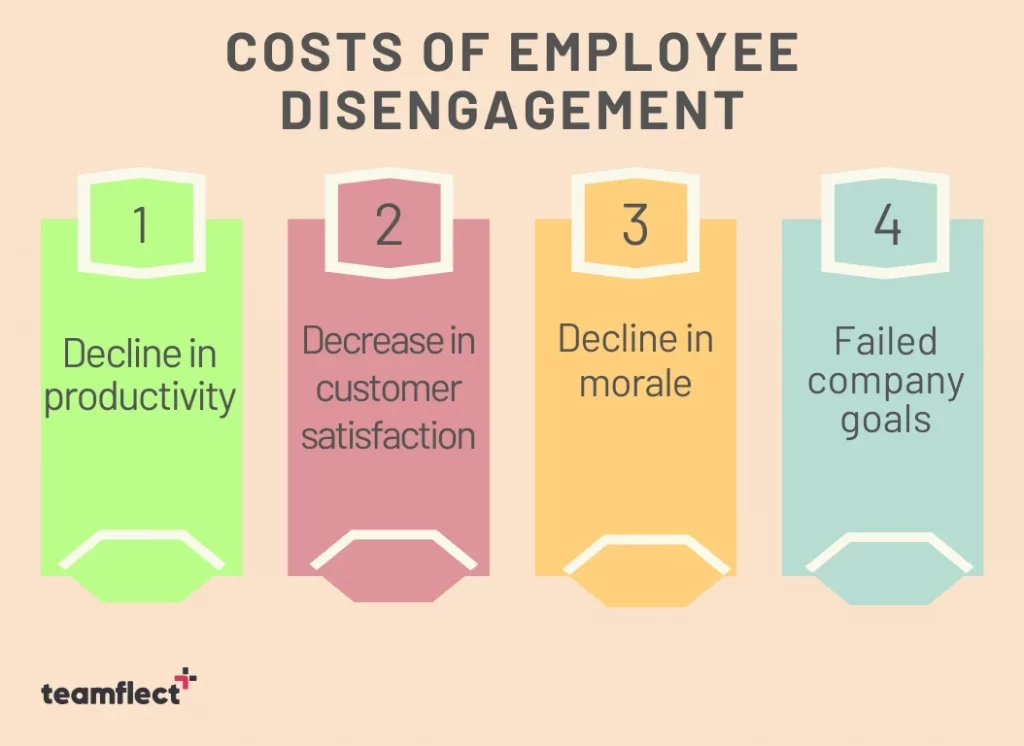
Employee disengagement is like a domino effect when it comes to its costs. What we mean by this is that it doesn’t only affect one person but it negatively affects company culture by causing a decline in morale and productivity. When your employees are disengaged, it will be harder for you to achieve your company goals.
1. Decline in productivity
The correlation between decreased productivity and disengagement at work is an obvious one. Therefore, when we think of the organizational consequences of employee disengagement, reduced productivity automatically pops up in our heads.
But this intuitive thinking is backed up by research too. According to a study, when employees are feeling disengaged at work, they will be less productive, and less likely to meet performance expectations and their error rate will increase by 60%.
2. Decrease in customer satisfaction
Employee engagement rates in businesses with above-average customer satisfaction ratings are 79%, compared to 49% in businesses with below-average or average ratings.
This demonstrates a link between customer experience and employee engagement because as engagement rates increase, customer satisfaction scores go up as well.
3. Decline in morale
When your employees are not engaged at work, company culture suffers. Not engaged employees will cause a decline in morale since they tend to be absent from work. This will lead to understaffing and burnout among other employees.
Contrary to disengaged employees, engaged workers are not only physically present but give their all to accomplishing the company goals. This might be related to being recognized for their efforts and accomplishments and they might be reciprocating with hard work and contributions.
4. Failed company goals
Why would an employee want to work productively and hit organizational goals if they are disengaged? The answer is that they don’t! When people are disengaged they won’t see the value of working for their organization at all.
Psychology of employee disengagement
Let’s start this section with a handy framework that will help us understand the dynamics of employee-employer relationships. Social exchange theory (SET) was developed by Gouldner (1960) Homans (1961), Blau (1964), and Emerson (1976).
This theory provides valuable insight into how interactions between individuals or groups are shaped by benefits and costs. More specifically, human interactions are seen as the result of benefit-cost estimations and if one interaction is perceived as more beneficial, we are inclined to repeat it.
Now, let’s apply this theory to the workplace. Rewards in the workplace can be employee recognition, financial incentives, and promotions. However, according to Franklin M. Lartey (2021), elements like career planning, employee autonomy, and manager feedback all play an important role in creating employee engagement without a monetary incentive.
Why? Because they function as rewards in exchange of productive and positive employee behavior. According to Lartey, organizations can formulate a three-step plan to boost employee engagement. In the next section, we will be explaining these three steps that are most useful in engaging your employees.
Best practices for employee engagement
“The ability to engage employees, to make them work with our business, is going to be one of the greatest organizational battles in the coming years.”
Mike Johnson, The New Rules of Engagement (2010)
This quote by Mike Johnson rings true in today’s business atmosphere because as we mentioned earlier, the ratio of engaged employees to disengaged ones hit its lowest since 2013 in the US. So, we need more effective employee engagement strategies to overcome this issue.
For this reason, we are providing you with a three-step action plan to solve the employee disengagement problem. According to research these non-monetary practices of employee engagement are very effective in engaging your employees.
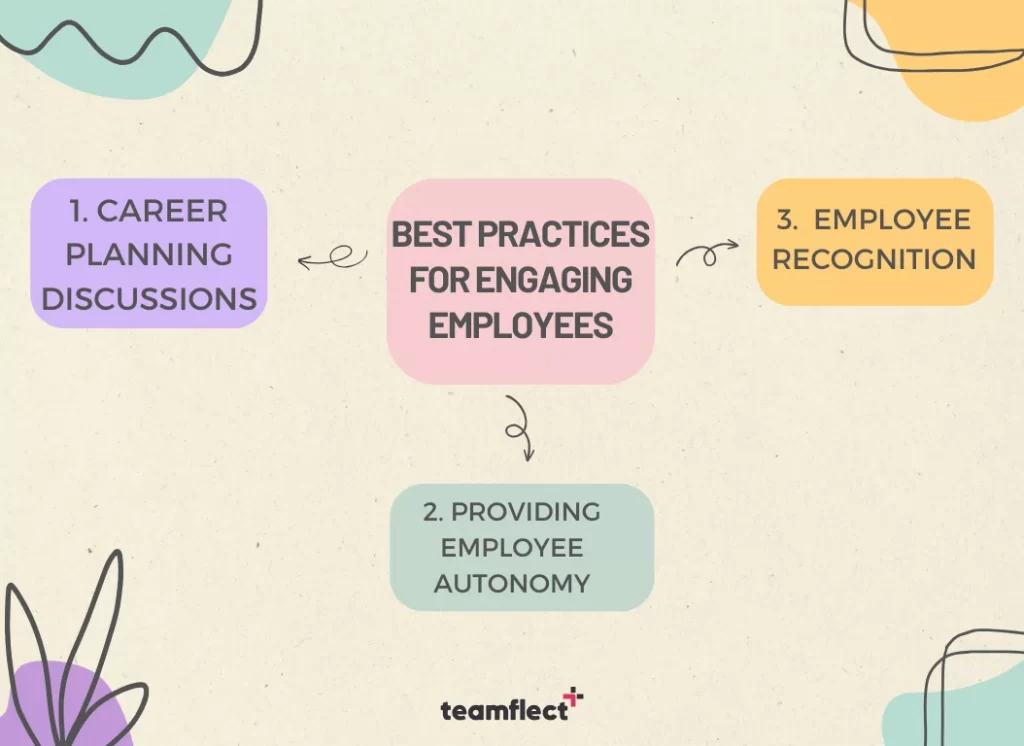
1. Career planning discussions
The first step to engaging your employees is having career-planning discussions with them. According to the research by Franklin M. Lartey (2021), career planning was the biggest contributor to employee engagement. Employees should know that if they perform well, they will be able to progress within a company.
This progression could be toward a supervisory role or toward a different department in the same organization.
It’s an effective practice to have a progression plan for each employee within your company. However, we said engaging employees is a two-way relationship, so employees need to have positive attributes for managers to discuss progression possibilities with them.
And this brings us to our next step of creating employee engagement.
2. Providing employee autonomy
As said above, to have career progression discussions with your employees, they need to be promising and they should be trusted. In return of this trust, managers will provide them with autonomy.
Supervisors should try to avoid micromanagement as much as possible since in the absence of autonomy, employees tend to be stressed. This stress will cause employee disengagement and a decline in job performance.
3. Employee recognition
According to Lartey (2021), recognition is another way of telling your employees that they are on the right track to achieving their goals and therefore career progression. In other words, it creates an anticipation for career advancement.
On top of that, employee recognition is important because by recognizing your employees you are saying that they have made a meaningful contribution which is another verbal incentive that will reduce employee disengagement.
Use the best employee recognition software: Teamflect
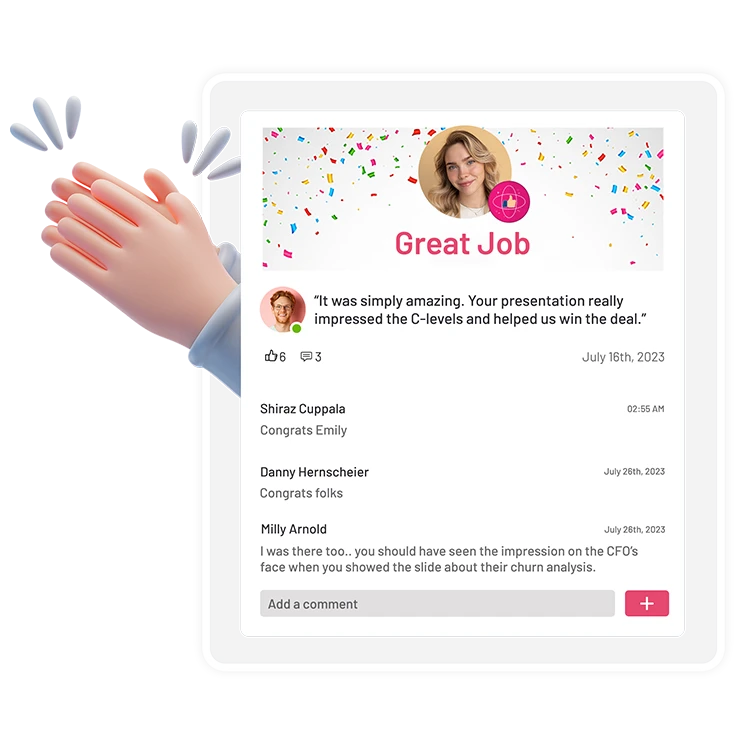
When it comes to giving recognition to your employees, you want a user-friendly tool. That’s where Teamflect steps in and the fact that it seamlessly integrates into Microsoft Teams makes it even more intuitive.
With Teamflect, you can send recognitions to your preferred Microsoft Teams channels. But, there’s more! You can also create customizable reports to keep your engagement levels high, adding an extra layer of protection to keep your employees engaged.
Plus, when you pair up the best employee recognition software, Teamflect, with Microsoft Teams, sharing your recognitions will be effortless since you won’t need to switch between platforms.
